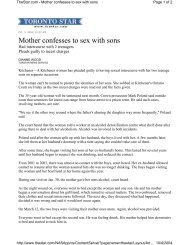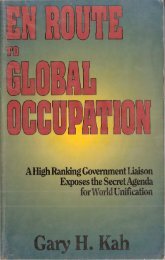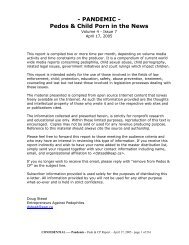G. Edward Griffin - The Fearful Master - PDF Archive
G. Edward Griffin - The Fearful Master - PDF Archive
G. Edward Griffin - The Fearful Master - PDF Archive
You also want an ePaper? Increase the reach of your titles
YUMPU automatically turns print PDFs into web optimized ePapers that Google loves.
peaceful solution to the conflicts present in the world. <strong>The</strong> question is:<br />
on what foundation will the edifice of peace be built? UNESCO claims to<br />
supply this foundation, but when its claims are investigated, they are<br />
found to be empty as well as a convenient cover for its real activities.<br />
<strong>The</strong> foundations of UNESCO are atheistic and materialistic. For it, man<br />
is the highest product of nature rather than one created in the image<br />
and likeness of God. This view of God and man dictates UNESCO's<br />
methods and. can be seen in them. Rather than being genuinely<br />
concerned with, the intellectual and moral development of men through<br />
education, UNESCO makes cynical use of those whom it professes to<br />
be serving and helping; rather than assisting people to grow and accept<br />
responsibilities, UNESCO preys upon those with whom it comes in<br />
contact and is more than glad to assume covertly or overtly all<br />
responsibilitv. 13<br />
Look at a few examples. <strong>The</strong> book How the United Nations Works by Tom Galt is one of<br />
the children's books recommended by UNESCO. 14 It also comes highly praised by the<br />
New York Times, the Saturday Review of Literature and the New York Herald Tribune as<br />
well as the United Nations Information Service. In the opening paragraphs the reader is<br />
informed that the United Nations is "the most important organization that has ever been<br />
created on this earth." As for accuracy of information in this book, the following is typical.<br />
<strong>The</strong> author describes the UN organizational meeting in San Francisco in 1945. On page<br />
20 he says that while the delegates were meeting in the opera house, Japanese bombs<br />
drifted overhead on balloons and exploded in the hills near the city! On page 9, the author<br />
skillfully plants a typical UNESCO attitude in the minds of his young readers by saving that<br />
when he was a boy his teachers and school books told him:<br />
<strong>The</strong> U.S. is always good and noble. We never fought a war except in<br />
self-defense. We have always been kind and generous to other<br />
countries. But the people of other countries are dishonest and mean.<br />
<strong>The</strong>y will always cheat you. <strong>The</strong>y never take baths.<br />
You and the United Nations is another children's book highly recommended and praised<br />
by UNESCO. 15 Written and illustrated by Lois Fisher, it is designed for the very young. It is<br />
crammed with clever drawings and appropriate captions to catch the imagination of<br />
children too young to understand the more complicated and sophisticated United Nations<br />
arguments. For instance, all pro-UN figures are characterized as wholesome and<br />
intelligent. Those who are against the UN are presented as ridiculous and evil. One<br />
classic illustration depicts our Founding Fathers as three extremely ugly and grotesque<br />
cross-eyed creatures snarling at each other while a rat watches from the floor.<br />
This is the kind of conditioning of children's attitudes that Luther Evans had in mind when<br />
he addressed a UNESCO meeting and said:<br />
UNESCO's is a radical program. <strong>The</strong> rewards may be visible ten years<br />
from now; again they may not be visible for a hundred years. . . . <strong>The</strong>y<br />
are instilled into the daily habits of mind of rising generations-perhaps<br />
not the first, not the second, but ultimately, it must be so. . . . To make<br />
the system of the UN and its specialized agencies work, we must sweep<br />
past traditional barriers in our thinking toward new frames of<br />
reference. 16



![Robert T McQuaid [rtmq@stn.net] Sent: Friday, October 29, 2004 12 ...](https://img.yumpu.com/51070071/1/190x245/robert-t-mcquaid-rtmqstnnet-sent-friday-october-29-2004-12-.jpg?quality=85)







